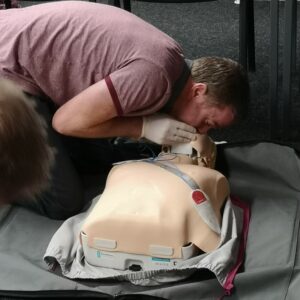First Aid
Courses
First aid training is training that will be useful in your daily life and that you will carry the skills for eternally. Accidents happen, inside or outside of your place of work. Have the confidence in being prepared for any situation with these courses.
Equipped with the knowledge from our courses, you will be prepared in case of any emergency. This type of training can save lives and prevent minor injuries from becoming major ones.
The Health and Safety Regulations 1981 require work places to provide adequate first–aid equipment, facilities and appointed people so employees can be given immediate help if they are injured/taken ill at work. Various levels of training are appropriate depending on the requirements at the particular work place.

FAQs
The certificate lasts for three years from issue date and candidates must complete the re-qualification course within 28 days of expiry of the current certificate.
As a minimum, the HSE requires employers to provide a first aid kit – preferably one that is compliant with BS 8599 (the standard for UK kits). There is no mandatory list of items to include, so the contents should be influenced by the outcome of your needs assessment.
As a guide, the HSE lists an example of what a first aid kit may include where the work activities are low risk:
- A leaflet giving general guidance on first-aid.
- At least twenty individually wrapped sterile plasters in assorted sizes that are appropriate to the type of work being undertaken (hypoallergenic plasters can be provided if necessary).
- Two sterile eye pads.
- Two individually wrapped triangular bandages – preferably sterile.
- Six safety pins.
- Two large, sterile, individually wrapped unmedicated wound dressings.
- Six medium-sized sterile individually wrapped unmedicated wound dressings.
- At least three pairs of disposable gloves (see the HSE’s guidance on latex gloves).
However, this is not an exhaustive list of what your kit should contain: additional risks outlined in your first-aid needs assessment may mean you require further resources.
Because the duties of a first-aider can be physically and mentally demanding, it’s important to make the right choice. You should consider the following factors when choosing employees to fulfil this role:
- Willingness: Is being a first-aider something the employee actually wants to do? Is it something they can take pride in?
- Capability: Is the employee mentally able to fulfil the role? Are they calm and confident enough to act reasonably in the case of an emergency?
- Ability: Is the employee physically able to perform first-aid?
- Availability: Can the employee fulfil the first-aider role without it affecting their work?
You must also have first aiders on site at all times, factoring in annual leave, shift patterns and absences, so it’s important to bear this in mind as well.
Because there is no one-size-fits-all approach to first aid in the workplace, employers should undertake a first aid needs assessment.
According to HSE guidelines, your needs assessment should consider:
- The nature of the work and workplace hazards and risks.
- The nature of the workforce.
- The organisation’s history of accidents.
- The size of the organisation.
- The needs of travelling, remote and lone workers.
- Work patterns.
- The distribution of the workforce.
- The remoteness of the site from emergency medical services.
- Employees working on shared or multi-occupied sites.
- Annual leave and other absences of first-aiders and appointed persons.
- Understand the provisions for non-employees.
The Health and Safety Regulations 1981 sets out the key aspects of first aid that all employers should address to keep their employees safe in the workplace. As the HSE (Health & Safety Executive) explains, the regulations require employers to provide ‘adequate and appropriate equipment, facilities and personnel to ensure their employees receive immediate attention if they are injured or taken ill at work’.
These regulations apply to all businesses, including those with fewer than five employees and the self-employed – so whatever the size of your business, duty holders have a responsibility to put the necessary provisions in place.
The measures are considered to be ‘adequate and appropriate’ depend on the circumstances in each workplace. The employer or duty holder (the person tasked with maintaining health and safety in the workplace) should therefore carry out an assessment of needs to determine exactly what should be provided.

